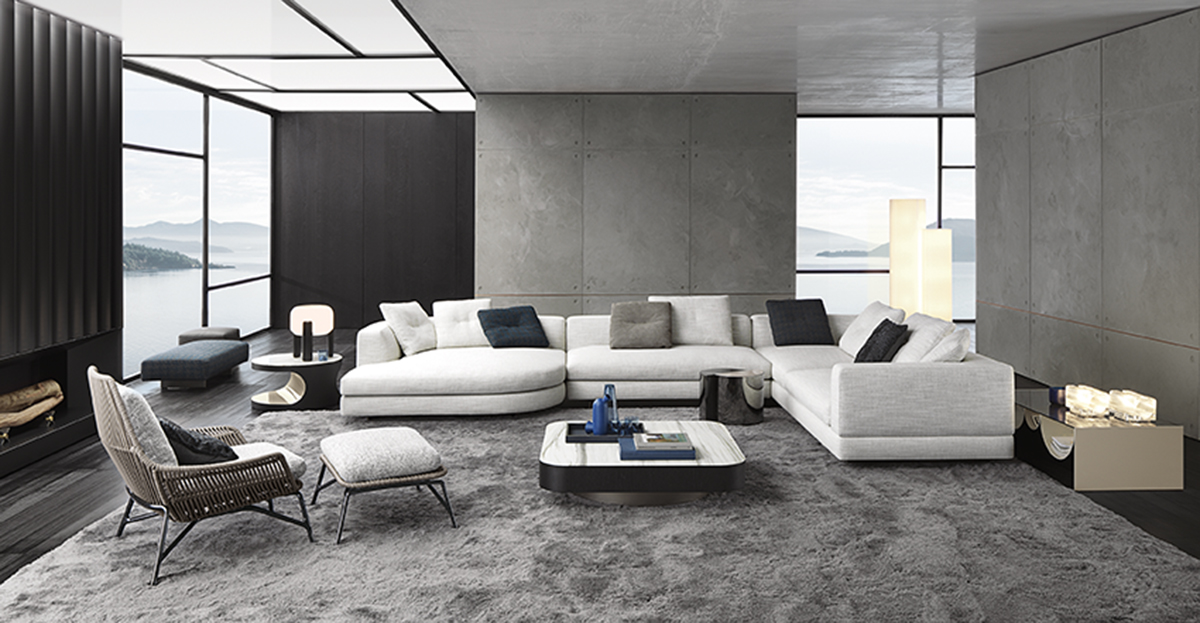Your 70th birthday is a great opportunity to take stock of the present and look to the future…
We’re now into what we define as the “third phase” of Minotti as a brand. The first phase coincided with the first, significant changes we made at the company in the mid-1980s, at which time the image of the company really evolved and we abandoned extreme classicism in favour of a contemporary style. Our father was a great role model for us back then – he gave us room to manoeuvre while also supporting us with advice and suggestions. That in turn allowed us to tackle the “second phase” of Minotti, when we built the company into a solid commercial entity. It was a challenge we tackled in collaboration with Rodolfo Dordoni – the partnership is this year marking its 20th anniversary. Working with Dordoni – who is responsible for coordinating our collections – we looked at what we could add to inject new impulse into the company. From there, we moved into the “third phase”, which saw us open up and begin launching external creative collaborations. The first was with Christophe Delcourt last year and we’re now working with Nendo – to create a line of products mainly targeted at the hospitality industry – and Marcio Kogan, whose approach to product design is a natural extension of his architectural style. We’re already devising our style strategy for 2018 – we have plenty of ideas and are brimming with energy. We have the youngsters supporting us and an extraordinary team, which is a vital factor because you cannot do business without a good team at your side.


Minotti is synonymous with its family identity. Is there another value or principle that has helped you get to where you are today?
If I had to sum it up in one word I’d go with “passion”. It’s a term that we use – and hear – frequently. We believe in passion in the truest sense of the word because we really do love what we do.
The brand has taken on a more international dimension in recent years, but still maintains a strong bond with Italy – take the company headquarters, for example.
Two years ago, as part of the third phase of the company, we increased the 5,000m2 production area adjacent to our company headquarters. This was done in order to support the next stage in the evolution of our collections – we expanded Minotti Studio and created new senior roles in the creativity, communication and production sectors, thus enhancing an already strong team. The third generation of the Minotti family is also part of that team, observing what we do and preparing for the future.
From our headquarters, we are able to maintain direct control over the entire production chain, all of which is located no more than 30 to 40 kilometres from us.
In terms of the overseas markets, we’ve created area managers and agents whilst at the same time investing in back office and boosting client services in order to ensure functionality and quick response times.

Which collections best capture what this milestone anniversary represents?
Definitely the special edition of Albert&Ile, a collection of seating and side tables. Part of the Minotti Historic Archive, the collection was originally designed in the 1960s by Gigi Radice, with whom our father worked for many years, a bit like we’re doing with Rodolfo Dordoni now. It was Radice that designed our parents’ house in Meda – it’s an iconic building, a timeless example of architectural rationalism. In the same way, Albert&Ile is a product collection that represents a perfect example of the company’s contemporary spirit, despite their vintage feel. They’re a fitting tribute to our origins and – above all – to our father Alberto and mother Ileana, who is currently the company’s honorary president.

Over the years, Minotti has come to represent the benchmark for style in the industry. How do you achieve such authority?
I would say discipline has been key. We’ve always taken it one step at a time without ever letting the desire to generate big numbers get in the way. We’ve kept an “artisanal” approach to our work – that means ensuring attention to detail and quality, which are two values on which we’ve never compromised. On top of that, we’ve ensured good consistency in terms of our image and always worked hard to contextualise products within suitable interior styles.

So how would you sum up the Minotti style?
We’ve always tried to convey an identity that is unique and distinctive. When we started working with Dordoni, it was at a time in which companies generally preferred to work with a larger pool of designers. Yet we like to ask the creative to channel their genius into our projects in a way that merges with our company identity. Our ambition is to create settings and feelings that can surprise but not shock. For example, up until last year our style was more decorative, whereas this year we’ve gone for a more graphic, bright approach. I think visitors to Milan Furniture Fair were definitely positively surprised. That’s our way of doing things and will always remain so.









